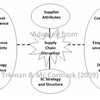 Although going on 10 years hold, much of this handbook still holds true. I found it by accident when reading a PhD thesis from Sweden on supply chain risk and the translation of the Swedish book “Säkra företagets flöden”, published in 1999 by the Swedish Emergency Management Agency was supposed to be my Christmas pastime. However, other things took priority, but now it’s time to finish this project. Today’s post will taker a closer look at the transportation system itself.
Although going on 10 years hold, much of this handbook still holds true. I found it by accident when reading a PhD thesis from Sweden on supply chain risk and the translation of the Swedish book “Säkra företagets flöden”, published in 1999 by the Swedish Emergency Management Agency was supposed to be my Christmas pastime. However, other things took priority, but now it’s time to finish this project. Today’s post will taker a closer look at the transportation system itself.
Intermodality
Transportation runs along four different modes: sea, air, road and rail. Most goods will change it’s mode somewhere along the route, and in most supply chains that is predominantly sea to road or sea to air or vice versa. Splitting the goods into pallet-size or container-size ensures intermodality. However, not all goods can be shipped intermodally, some require a certain form of transport, because they are too heavy or too bulky or are needed in a hurry. Relying too heavily on one mode can be risky. On the other hand, it may also be that there is only one mode available, say roads, say in rural areas. (See my article on sparse transportation networks for a characterization of supply chains). Intermodality, and the ability to switch from one mode to another, is no guarantee against disruptions. More often than not, the more normal and everyday sort of disruptions occur in the terminals and not enroute.
Risks and threats
The threat of disruptions increases as companies reduce their stocks and inventory to the minimum while at the same time demanding a more punctuality, shorter lead times and higher quality. Among the many risks and threats, here are some of the more typical that can lead to delays and disruptions:
- Technical breakdowns, accidents and mishaps
- Lack of spare parts or repair capabilities
- Lack of fuel
- Wrong loading or mixing of goods (hazardous mixed with non-hazardous)
- Weather-related (floods, snow, closed routes)
- Theft or other criminal acts
- Legal issues (non-compliance with regulations)
- Workforce issues (strike)
- Political issues (demonstrations, unrest)
- Monetary/financial issues (bankruptcy among one of the parties in the supply chain)
- Incomplete or missing permissions or approvals by transportation authorities
- Incomplete or missing documents
- Incomplete or erroneous instructions for handling the shipped goods
- Congestion
- Breakdown in IT, electricity, radio-and telecommunications
The freight handler’s legal and financial status is also of major importance. Can he be trusted? In a worst case scenario, your goods may be uninsured because he was denied insurance. Financial troubles are often reflected in the standard of equipment that is used, old and wore-down trucks are not a sign of reliability or high quality standards.
Logistics Manager?
To ensure that the supply chain or transportation flows to and from the company are working in the best possible manner, the handling of a company’s transportation needs must be assigned to a clearly defined role within the organization. (In my experience, more often than not ingoing and outgoing flows are split between the purchasing and sales departments with no overall oversight. This is particularly true in a 2PL settings (2nd part logistics), but may also occur in a 3PL setting.
Checkpoints
When choosing your transportation partner, make sure you know the following about the company:
- What kind of vehicles do they use (fleet, age and standard)?
- What routes do the normally traffic?
- Who do they partner with?
- Do they have all permissions needed?
- Do they have full insurance coverage?
- What is their financial history?
- Do they use state of the art equipment?
These are just some of the points that should be considered when looking for a freight forwarder.
In case of disruptions, what will happen to your business?
Here is a list of question every business should ask:
- Are there alternatives? Other modes? Other routes?
- Are there other potential suppliers not affected by the disruption?
- Can the supplies be delivered or acquired from other than the usual sources without extra efforts/expenses?
- What does the delay/disruption mean to us? Our production? Our sales?
- How much disruption/delay can we withstand before the consequences are inacceptable?
- What does a delay/disruption mean to our customers? Short-term? Long-term?
- Do the delayed goods/supplies need special care/protection while delayed/in waiting? Can there be environmental consequences (spills/pollution)?
- Do we need to notify the authorities about the above?
- Have we been in touch with the freight forwarder about the above?
- Have all parties or stakeholders within our own company been informed properly?
- Do we (or the freight forwarder) have an information system that can keep us up-to-date on the whereabouts of the shipment?
Reference
Giertz, E., et al. (1999) Säkra företagets flöden, Silfgruppen, Stockholm. ISBN 91 7097 056-4
Related
- husdal.com: How to secure your supply chain – 1/7
- husdal.com: How to secure your supply chain – 2/7
- husdal.com: How to secure your supply chain – 3/7
- husdal.com: How to secure your supply chain – 4/7
- husdal.com: How to secure your supply chain – 5/7
- husdal.com: How to secure your supply chain – 6/7
- husdal.com: How to secure your supply chain – 7/7












